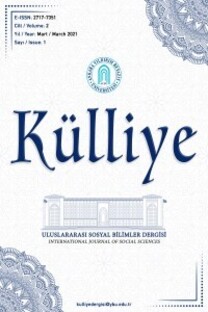Kazakistan’da Siyasi Baskı Mağdur Müzeleri ve Millet İnşası
Bu çalışma kısaltması ALJİR olan, Rusça “Vatan Hainlerinin Eşleri İçin Akmolinskiy Toplama Kampı" yerinde inşa edilen ALJİR Anıtı ve Müzesi Külliyesi örneğinde Siyasi Baskı Mağdurları Müzelerinin Kazakistan millet inşasında nasıl bir rol aldıkları hakkındadır. Son otuz yılda mağdur müzelerinin sayısında patlama yaşanmıştır. Özellikle eski koloniler millet inşasında bu tür müzeleri kullanmaya başladılar. Rus Çarlığı istilası ve Sovyet döneminde en çok zarar gören ve bağımsızlıkta Kazakların ülke nüfusunun üçte birini oluşturduğu Kazakistan, millet inşası ve tarih yazımında en dezavantajlı ülke konumundaydı. Bunu yaparken- Rusya dâhil-diğer Sovyetler Birliği ülkeleri gibi, mağdur anıtları ve müzeleri kullanmaktan çekinmedi. İçerik analizi ve söylem analizi yöntemleri kullanılan makalenin tezi, Kazakistan aynı anda uygulamaya çalıştığı Kazakistan ve Kazak milliyetçiliğinin bir parçası olarak, bu mağdurlar müzeleri bütün etnik gruplara yönelik olduğu için, Kazak milliyetçiliğine değil Kazakistan milliyetçiliğine yönelik olarak tasarlanmış ve zulmü yapan olarak Stalin gösterilmiş; Ruslar, Sovyetler Birliği, hatta komünizm bile zulmün parçası olarak sunulmamıştır.
Anahtar Kelimeler:
Mağdurlar Anıt ve Müzeleri, Millet inşası, Kazakistan, ALJİR, GULAG
The Role of the Museums of the Political Repression in Nation Building: The Case of the ALJİR Memorial Complex in Kazakstan
During the last thirty years there has been an explosion in the number of memorial museums. Especially the old colonies started to use such museums in nation-building. Kazakhstan was the most disadvantaged country in nation-building and history writing because only one-third of the population was Kazakhs in independence due to policies of the Russian and Soviet Empires. Kazakhstan did not hesitate to use memorial museums in nation-building. This work is about the role of the Museums of Victims of Political Oppression in nation building of Kazakhstan in the case of the ALJİR Memorial and Museum Complex which was built on the site of Akmolinskiy Concentration Camp for the Wives of the Homeland Traitors. Since independence Kazakhstan has implemented both Kazakhstani and Kazakh nationalism, ALJİR complex appealed to Kazakhstani nationalism because oppression was implemented to all ethnic groups. Stalin was shown as only culprit; the Russians, the Soviet Union, and even communism were not presented as part of the persecution.
Keywords:
Memorial Museums, National Building, Kazakhstan, ALJİR, GULAG.,
___
- 15 Temmuz Müzesi İlk Kez Görüntülendi. (2018, Temmuz). TRT Haber. https://www.trthaber.com/haber/kultur-sanat/15-temmuz-muzesi-ilk-kez-goruntulendi-375419.html
- Aitymbetov, N., Toktarov, E., & Ormakhanova, Y. (2015). Nation-Building in Kazakhstan: Kazakh and Kazakhstani Identities Controversy. Bilig, 74, 20.
- Aktoprak, E. (2010). Devletler ve Ulusları: Batı Avrupa’da Milliyetçilik ve Ulusal Azınlık Sorunları. Tan Kitabevi Yayınları.
- Alexander, E. P., Alexander, M., & Decker, J. (2017). Museums in Motion: An Introduction to the History and Functions of Museums (3rd ed.). Rowman & Littlefield.
- ALJİR Museum-Memorial Complex. https://www.lonelyplanet.com/kazakhstan/attractions/alzhir-museum-memorial-complex/a/poi-sig/1384251/356857
- Anderson, B. (1991). Imagined Communities: Reflections on the Origin and Spread of Nationalism. Verso. Anıtlar Ve Müzelerle 15 Temmuz... (2023, Temmuz 15). Yeniasır. https://www.yeniasir.com.tr/gundem/2023/07/15/anitlar-ve-muzelerle-15-temmuz
- Aydın, M. (2005). Geçiş Sürecinde Kimlikler: Orta Asya’da Milliyetçilik, Din ve Bölgesel Güvenlik. In M. Aydın (Ed.), Küresel Politikada Orta Asya. Nobel Yayıncılık.
- Bennett, T. (2020). The Birth of the Museum: History, Theory, Politics. Routledge Lightning Source UK.
- Calhoun, C. J. (1997). Nationalism. Univ. of Minnesota Press.
- Duncan, C (1991). Art Museums and the Ritual of Citizenship. In I. Karp & S. Lavine (Eds.), Exhibiting Cultures: The Poetics and Politics of Museum Display (pp. 88–103). Smithsonian Institution Press.
- Collins, K. (2006). Clan Politics and Regime Transition in Central Asia. Cambridge University Press. https://books.google.kz/books?id=L5PYDqrKOPQC
- Gürbüz, E. (2004). Kazakistan’da Bir Ulus-Devlet Kurmak. Praksis, 11, 191–220.
- Kazakhstan Is Our Common Home. (2009, October 27). Kazinform. https://www.inform.kz/en/kazakhstan-is-our-common-home_a2207752
- Kudaibergenova, D. T., & Shin, B. (2018). Authors and Authoritarianism in Central Asia: Failed Agency and Nationalising Authoritarianism in Uzbekistan and Kazakhstan. Asian Studies Review, 42(2), 304–322. https://doi.org/10.1080/10357823.2018.1447549
- Kuzio, T. (2002). History, Memory and Nation Building in the Post-Soviet Colonial Space. Nationalities Papers, 30(2), 241–264. https://doi.org/10.1080/00905990220140649
- Martin, V. (2001). Law and Custom in the Steppe: The Kazakhs of the Middle Horde and Russian Colonialism in the Nineteenth Century. Curzon. http://www.vlebooks.com/vleweb/product/openreader?id=none&isbn=9781136123788
- National Unity Doctrine. (2016). Assembly of People of Kazakhstan. https://assembly.kz/en/national-unity-doctrine
- Natsionalnyy Doklad O Sostoyanii i Razvitii Sistemy Obrazovaniya RK (Kazakistan Cumhuriyeti Eğitim Sisteminin Durumu ve Geliştirilmesi Üzerine Ulusal Rapor). (2017). Kazakistan Cumhuriyeti Eğitim ve Bilim Bakanlığı. http://edu.gov.kz/ru/statistika-i-analitika/detail.php?ELEMENT_ID=1774
- Nazarbaev, N. (2006). Kazakhstanskiĭ putʹ (Kazakistan Yolu). Arko.
- Nazarbaev, N. (2018). Seven Facets of the Great Steppe(Ulu Bozkırın Yedi Boyutu). Akorda.Kz. http://www.akorda.kz/en/events/akorda_news/press_conferences/article-of-the-president-of-the-republic-of-kazakhstan-nursultan-nazarbayev-seven-facets-of-the-great-steppe
- Nazarbayev Laid Flowers at Victims of Political Repression Memorial. (2017). Kazinform. http://kabar.kg/eng/news/kazinform-president-nazarbayev-laid-flowers-at-victims-of-political-repression-memorial/ Olcott, M. B. (1995). The Kazakhs. Hoover Institution Press. https://books.google.kz/books?id=0QAraz9qVY4C
- Sodaro, A. (2018). Exhibiting Atrocity: Memorial Museums and the Politics of Past Violence. Rutgers University Press.
- Statistical Image of Kazakhstan Education. http://iac.kz/en/publishing/statistical-image-kazakhstan-education
- The Address of President of the Republic of Kazakhstan N. Nazarbayev to the People of Kazakhstan.
- November 11, 2018. (2018). Official Site of the President of the Republic of Kazakhstan. http://www.akorda.kz/en/addresses/the-address-of-president-of-the-republic-of-kazakhstan-nnazarbayev-to-the-people-of-kazakhstan-november-11-2014
- The Assembly of People of Kazakhstan. Official Site of the President of the Republic of Kazakhstan. http://www.akorda.kz/en/national_projects/the-assembly-of-people-of-kazakhstan
- The Forgotten Women of the Gulag. (2009). Eurasianet. https://eurasianet.org/the-forgotten-women-of-the-gulag
- Ulucanlar Cezaevi Müzesi Halka Açıldı. (2011, June 16). Milliyet Haber. http://www.milliyet.com.tr/ulucanlar-cezaevi-muzesi-halka-acildi-gundem-1403184/
- Williams, P. H. (2007). Memorial Museums: The Global Rush to Commemorate Atrocities. Berg.
- Yayın Aralığı: Yılda 2 Sayı
- Başlangıç: 2020
- Yayıncı: Sıddık Çalık
Sayıdaki Diğer Makaleler
Göbekli Tepe'den Hayvan Tasvirleri
Avrupa Güvenliğinde NATO-PESCO İlişkileri: İş Birliği Mi İkilem Mi?
ARGONUN KURAMSAL YAPISI ve ESİR ŞEHRİN MAHPUSU ÖRNEĞİ
Benzersiz Bir Sözlükçe Mühendisliği Örneği: Türk Dil Devriminde Kasıtlı Etimolojik Tahrif
Türkiye’nin Ekonomi Tercihi Bağlamında 1946 Devalüasyonu
Kazakistan’da Siyasi Baskı Mağdur Müzeleri ve Millet İnşası
Türkçe ve Kırgızca’da “Çocuk” Kavramı Üzerine
ORYANTALİST GÖRÜŞLERİ ELEŞTİRİ AÇISINDAN İSLÂM-TÜRK ANSİKLOPEDİSİ
DOĞUDAN BATIYA ANADOLU’DAKİ ANITLAR ÜZERİNDE AKHAİMENİD ETKİLERİ
